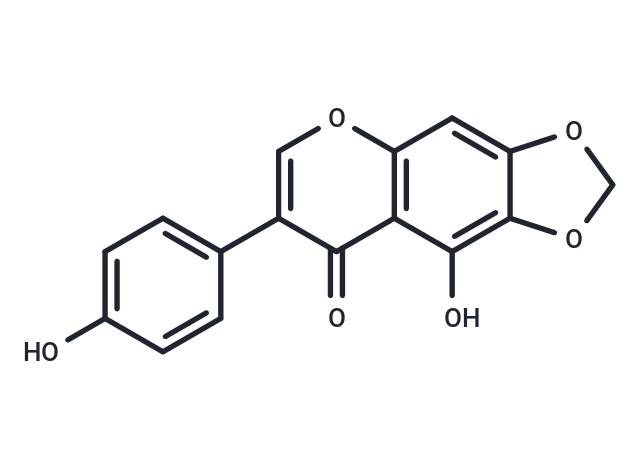Shopping Cart
- Remove All
 Your shopping cart is currently empty
Your shopping cart is currently empty

Irilone is a flavonoid with α-amylase inhibitory activity and highly selective inhibition of CYP3A4. In addition, Irilone enhances progesterone receptor (PR) signaling via estrogen receptor (ER) and glucocorticoid receptor (GR) when combined with progesterone.Irilone has potential anti-inflammatory activity and inhibits nitric oxide (NO) production by lipopolysaccharide (LPS)-induced RAW264.7 in mouse macrophages.

| Pack Size | Price | Availability | Quantity |
|---|---|---|---|
| 5 mg | $678 | Backorder |
| Description | Irilone is a flavonoid with α-amylase inhibitory activity and highly selective inhibition of CYP3A4. In addition, Irilone enhances progesterone receptor (PR) signaling via estrogen receptor (ER) and glucocorticoid receptor (GR) when combined with progesterone.Irilone has potential anti-inflammatory activity and inhibits nitric oxide (NO) production by lipopolysaccharide (LPS)-induced RAW264.7 in mouse macrophages. |
| In vitro | The use of botanical dietary supplements is becoming increasingly popular for the alleviation of hormonal-based conditions such as hot flashes, premenstrual syndrome, and fertility. Estrogen and progesterone receptors (ER and PR) play an essential role in these processes. However, despite the fact that many therapies used to alleviate gynecological conditions act through PR-mediated mechanisms, few studies have investigated or identified any herbal natural product components that act on this receptor. METHODS AND RESULTS:In the current study, we used a progesterone response element (PRE)-luciferase (Luc) reporter assay to identify four phytoprogestins present in a standardized red clover (Trifolium pratense) extract. We found that the component Irilone (1) potentiated the effect of progesterone in both endometrial and ovarian cancer cell lines. In these cancers, progesterone action is generally associated with positive outcomes; thus the potentiating effect of 1 may provide entirely new strategies for enhancing progesterone signaling as a means of mitigating conditions such as fibroids and endometriosis. Formononetin (3) and biochanin A (4) exhibited mixed agonist activity, while prunetin (2) acted only as an antagonist. CONCLUSIONS: Collectively, these results suggest that the effects of red clover extract repeatedly observed in cultured cells and the inverse correlation between risk of various cancers and flavonoid intake may be due, in part, to altered progesterone signaling. |
| Alias | Irolone, 5,4'-Dihydroxy-6,7-methylenedioxyisoflavone |
| Molecular Weight | 298.25 |
| Formula | C16H10O6 |
| Cas No. | 41653-81-0 |
| Smiles | O=C1C(=COC=2C=C3OCOC3=C(O)C12)C=4C=CC(O)=CC4 |
| Relative Density. | 1.592 g/cm3 |
| Storage | Powder: -20°C for 3 years | In solvent: -80°C for 1 year | Shipping with blue ice. | |||||||||||||||
| Solubility Information | DMSO: 2 mg/mL (6.71 mM), Sonication is recommended. | |||||||||||||||
Solution Preparation Table | ||||||||||||||||
DMSO
| ||||||||||||||||

Copyright © 2015-2025 TargetMol Chemicals Inc. All Rights Reserved.